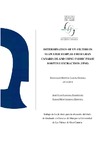Please use this identifier to cite or link to this item:
https://accedacris.ulpgc.es/jspui/handle/10553/74891
| Title: | Determination of UV-filters in seawater samples from Gran Canaria Island using fabric phase sorptive extraction (FPSE) | Authors: | García Guerra, Romualdo Bentor | Director: | Santana Rodríguez, José Juan Montesdeoca Esponda, Sarah |
UNESCO Clasification: | 2301 química analítica | Keywords: | Fabric phase sorptive extraction (FPSE) UV-filters Gran Canaria (Canary Islands) Seawater |
Issue Date: | 2016 | Abstract: | Fabric phase sorptive extraction (FPSE) is a new technique for the extraction of organic contaminants, including emerging contaminants. This technique integrates the advantages of sol-gel hybrid inorganic-organic sorbents with fabric substrates, being a highly sensitive, efficient and cheap device which moreover can be reused. FPSE coupled to ultra-high performance liquid chromatography with tandem mass spectrometry (UHPLC-MS/MS) has been employed to analyse benzotriazole UV stabilisers (BUVSs) compounds in seawater samples. BUVSs are a group of compounds added to personal care products (PCPs) such as sunscreens, soaps or shampoos, among others. Direct input in beaches or another aquatic recreational areas is the main source of BUVSs incorporation to the environment, where they can be mutagenic, toxic, pseudo-persistent and bioaccumulative. In this work, a FPSE-UHPLC-MS/MS methodology has been optimized and applied to analyse six BUVSs in thirty-six seawater samples from different coastal areas of Gran Canaria Island (Spain). The parameters that affect the FPSE procedure (sorbent chemistry, extraction time, sample volume, pH, ionic strength, back-extraction solvent, time and volume) were carefully studied and optimized in order to achieve a fast, reliable and sensitive separation and determination of the analytes. Under the optimum conditions, this methodology provided enrichment factors of 25 times with limits of detection (LODs) from 1.06 to 8.96 pg∙mL-1 and limits of quantification (LOQs) from 3.54 to 29.9 pg∙mL-1, for the BUVSs in study. FPSE got recoveries of the target analytes in the range from 9.30 to 51.4%, while the obtained intra and inter-day RSDs were between 3.97 and 20.8% for all compounds. The application of the optimised methodology to seawater samples allowed detect and quantify UV 360 in the range from 41.12 to 544.9 pg∙mL-1 in nine of them. | Department: | Departamento de Química | Faculty: | Facultad de Ciencias del Mar | Degree: | Grado en Ciencias del Mar | URI: | https://accedacris.ulpgc.es/handle/10553/74891 |
| Appears in Collections: | Trabajo final de grado Restringido ULPGC |
En el caso de que no encuentre el documento puede ser debido a que el centro o las/os autoras/es no autorizan su publicación. Si tiene verdadero interés en el contenido del mismo, puede dirigirse al director/a o directores/as del trabajo cuyos datos encontrará más arriba.
Show full item recordPage view(s)
70
checked on Feb 24, 2024
Download(s)
30
checked on Feb 24, 2024
Google ScholarTM
Check
Share
Export metadata
Items in accedaCRIS are protected by copyright, with all rights reserved, unless otherwise indicated.
